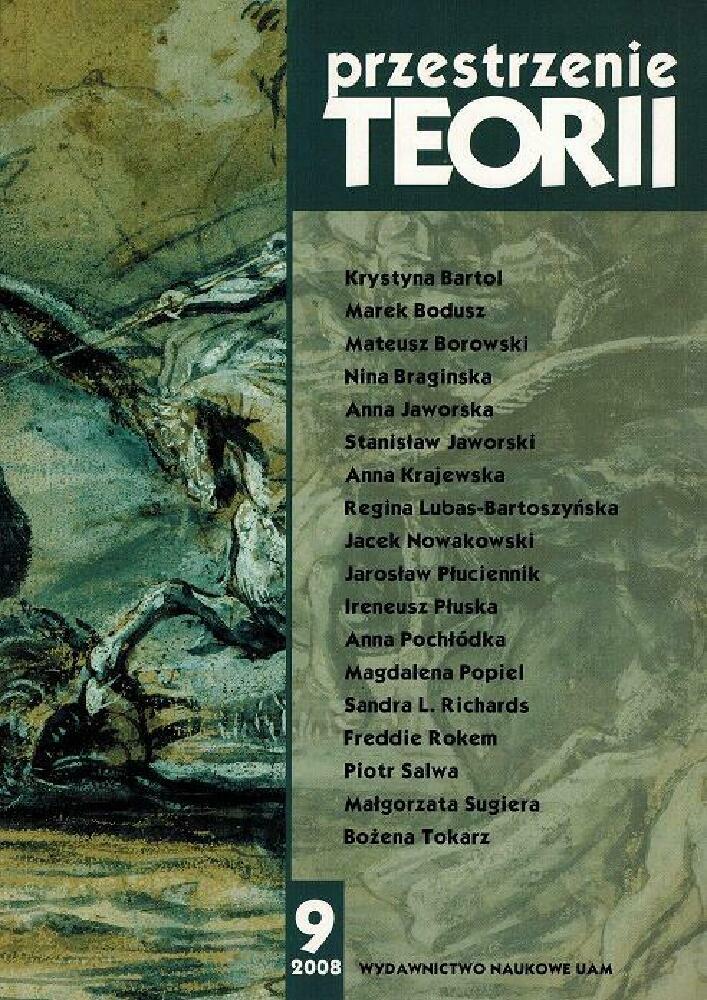Abstrakt
The aim of this article is to try to establish the place of Stanisław Wyspiański in the landscape of early Polish modernism. The methodological foundation is the anthropological aesthetics of literature. Analysis of the literary and plastic work as well as of the artist's remarks and observations dispersed in his letters and essays is the material for the construction of Wyspiański's conception of art. The starting point is the artist's existential experience, which assumes the form of atopy, experiencing of strangeness of that which is close. This experience becomes the subject of a literary transposition which is visible in many dramas: Wesele, Sędziowie, Wyzwolenie, Noc Listopadowa.
Its analogon is a dual aesthetic attitude which the artist assumes: an attitude of participation and an attitude of separation funding art which is based on panaestheticism or breaking of communication. In historical perspective the principle of artistic totality ("a play with fulness") and a tendency to degradation ("a play with emptiness") may be interpreted as a case of suspension between aesthetics of the 19th century and of the 20th century. Looking from the Polish angle, I propose to place Wyspiański in close vicinity of Stanisław Witkiewicz and Stanisław Ignacy Witkiewicz together with whom he would be creating a significant line of evolution of Polish modernity.
Licencja
Autorzy
Autorzy tekstów przyjętych do publikacji w czasopiśmie „Przestrzeniach Teorii” są zobowiązani do wypełnienia, podpisania i odesłania na adres redakcji umowy o udzielenie nieodpłatnej licencji do utworów, z zobowiązaniem do udzielania sublicencji CC.
Zgodnie z umową, autorzy tekstów opublikowanych w czasopiśmie „Przestrzeniach Teorii” udzielają Uniwersytetowi im. Adama Mickiewicza w Poznaniu niewyłącznej i nieodpłatnej licencji oraz zezwalą na użycie sublicencji Creative Commons Attribution-NonCommercial-NoDerivatives 4.0 International (CC BY-NC-ND 4.0).
Autorzy zachowują prawa do dalszego, swobodnego rozporządzania utworem.
Autorzy, którzy wykorzystują w swoim tekście cudze utwory (np. ilustracje, fotografie) proszeni są o dostarczenie do redakcji czasopisma zgodę na publikację od uprawnionych podmiotów.
Użytkownicy
Zainteresowani użytkownicy internetu uprawnieni są do korzystania z utworów opublikowanych po 2015 roku „Przestrzeniach Teorii” tylko w calach niekomercyjnych, pod następującymi warunkami:
- uznanie autorstwa - obowiązek podania wraz z rozpowszechnionym utworem, informacji, o autorstwie, tytule, źródle (odnośniki do oryginalnego utworu, DOI) oraz samej licencji;
- bez tworzenia utworów zależnych - utwór musi być zachowany w oryginalnej postaci, nie można bez zgody twórcy rozpowszechniać np. tłumaczeń, opracowań.
Do wszystkich tekstów opublikowanych przed 2015 r. prawa autorskie są zastrzeżone.
Inne
Uniwersytet im. Adama Mickiewicza w Poznaniu zachowuje prawo do czasopisma jako całości (układ, forma graficzna, tytuł, projekt okładki, logo itp.).
